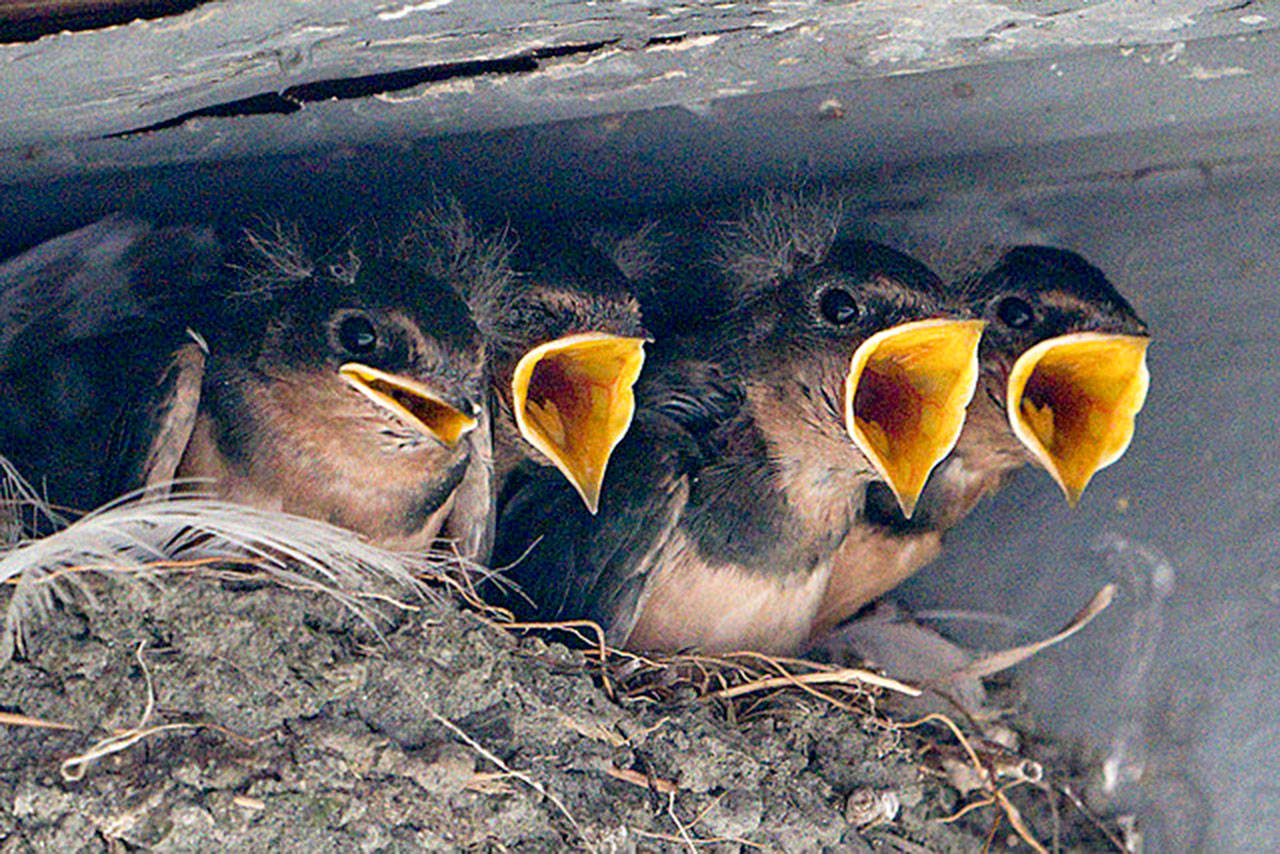Cherished for their faithful return, swallows have long been symbols of love, loyalty and peace. In Sequim, we don’t need to join other tourists going to Mission San Juan Capistrano in California to celebrate the swallows’ faithful yearly return. If you are fortunate to live near an agricultural field, pond, barn or river, you’ve already seen their swooping flight.
A pair can catch more than 500 insects a day when they are busy feeding their nestlings. While it’s hard to defend a territory as big as the sky, if you mistakenly get too close to a nest with young, you may get swooped and twittered!
In about three weeks, the hatched young are ready to fly for the first time. Once airborne, the parents fly alongside and help the young birds find home again.
Swallows (family Hirundinae) all share long narrow aerodynamic bodies, long pointed wings, and large mouths, which are their specialized adaptions to catching insects in flight. They are separated based on their nests. In Sequim we have six common swallow species and one infrequent visitor — the Bank Swallow.
The Barn Swallow is the most widely distributed and abundant swallow in the world, wintering in the southern hemisphere and breeding in the northern hemisphere, and our Sequim Barn Swallows arrive after a long migration from South America. They are distinctive, with forked tails and rusty throats.
Although Barn Swallows originally nested in caves, their association with humans has been long, and they have converted to building mud and grass nests under bridges and the eaves of buildings.
Considered a harbinger of good luck, swallows were the first bird protected by legislation (Milan, Italy 1496), and their destruction for the ladies’ hat industry in the late 1800s prompted the founding of the first Audubon Society in North America.
Today, pesticides are a serious threat to swallows, minimize their use in your yard to encourage more “natural” insect control, which the swallows are happy to provide.
Our other local swallows nest in tree cavities (Tree Swallow), build nests of mud alone (Cliff Swallows), use burrows or crevices (Northern Rough-winged Swallow) or adopt existing cavities (Violet-green Swallows and Purple Martins).
The beautiful Violet-green Swallows are especially suited to use swallow nest boxes in yards around Sequim. To enjoy watching your own swallow family grow up each spring — and have fewer mosquitoes — consider buying or building a nest box. Plans can be found at wdfw.wa.gov/species-habitats/living/woodworking-projects.
In early spring, the Olympic Peninsula Audubon Society also offers a “build your own” nest box event using pre-cut kits. Fully constructed and carefully sized boxes can be purchased at the Dungeness River Audubon Center, or at their annual holiday “Nature Mart.”
Purple Martins also use constructed nest boxes, but prefer boxes over water, necessitating special support for their colonies and nest boxes.
A community science project of the Olympic Peninsula Audubon Society maintains colonies of Purple Martins on Protection Island National Wildlife Refuge and at the Three Crabs Nearshore and Estuarine Restoration Area, a Washington Department of Fish and Wildlife Viewing Area along Dungeness Bay.
Recently, two additional colonies with nest boxes have been set up in Port Angeles and Dungeness Farms for these beloved birds.
To watch and listen to the friendly “chortles” of the Purple Martins, plan a visit to the Three Crabs Restoration Area. From the parking area at the west end of Three Crabs Road you can watch Purple Martins raise their families in the twenty-two nest boxes over the estuary and nearshore.
Judith White is President of the Olympic Peninsula Audubon Society.



